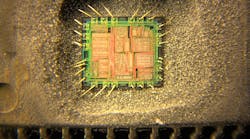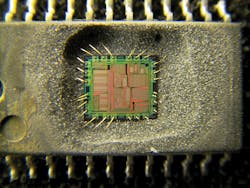This article is part of the TechXchange: Chip Shortages and Counterfeits
Download this article in PDF format.
In November of 2010, Jim Williams told me that Linear Technology, now part of Analog Devices, was seeing more and more counterfeit ICs. This is where some unscrupulous semiconductor company mislabels its inferior parts with Linear Tech’s or some other top-tier company’s logo and part number. They can sell the parts for a lot more money. Then the poor systems company that bought these chips would see they did not work in production and it would blame Linear Tech.
Sometimes a simple X-ray of the part would show it was not really an LT die in the package. Other times, Linear would “decap” the part, dissolving the plastic with fuming nitric acid, so that they could then see the die was a counterfeit (see figure). Occasionally there was no die at all, or a die that did not have bond wires to the IC pads.
Jim said that in the old days, he would hear about a counterfeit part maybe once a month. By 2010, he said it was happening multiple times per week. I saw this happen at National Semiconductor (now Texas Instruments) as well. A customer would be ranting at how we sold him thousands of bad parts. When we asked where he got the parts, he answered that it was some small gray-market distributor. We could see from the date code that the parts were counterfeit. I never saw a person change from yelling to begging so fast. He asked if there was any way National could get him 4000 parts that week. We did find him some parts, despite his being a low-volume customer. We warned him to be wary of any more “great unbelievable deals” from shady distributors.
This is one of the best reasons to pay a fair price from top-tier vendors that you see on SourceESB. I have never heard of counterfeit parts coming from Digi-Key, Mouser, or Newark. Arrow and Premier Farnell are trustworthy as well. This is not to say you can’t use smaller distributors or even those gray-market ones. Just be prepared to do an incoming test on the parts to ensure they meet all the specs. If so, it’s a good bet they are genuine.
Olli Niemitalo decapsulated this Yamaha YMF262 FM synthesis sound chip to view the semiconductor die that was inside. (Courtesy of Wikimedia)
Buying from salvage yards is really risky. I had an engineer pal that made $150,000 one year just going around to dumpsters in Silicon Valley and fishing rails of ICs out to sell to the salvage yard. When I was at National, there was a box of 4700 Boomer audio chips in the dumpster. I fished them out but then I asked the audio group about the parts. Same deal—when I told them the date code, they said the parts were not production parts but rather first-silicon prototypes that had problems. I tossed them back into the dumpster. I’m not sure if they made it to the Sunnyvale landfill.
Intentional Mislabeling
I mentioned Williams’ comment to my friend and mentor Bob Pease. While he did not have many stories of counterfeit ICs, he did tell me about a system company asking for its parts to be mislabeled, so that competitors could not easily reverse-engineer the design. It was after 11:00 at night when Bob sent a note:
“Here's a story I heard years ago. One of the early computer makers, I think it was Apple, was starting to get some success, and this was noticed. Some brilliant competitor decided they wanted to horn in on the success, so they bought the computer and copied everything, bill-of-materials, printed circuit board, etc. They got all the needed parts, even the relatively uncommon DM74LS245 in a 20-pin DIP (dual inline package).
“They built it up a few and applied juice, and nothing happened. They started to troubleshoot the board. It took a lot of work before they realized they'd been had. When Apple designed this computer, they were very thoughtful to buy the processor chip in a package labeled "DM74LS245." But even when the brilliant competitor went out and bought a microprocessor, it would not work because Apple's processor had various little bits of software instructions hidden away. The whole ‘copy it’ project just died. Not to mention the careers of the guys who just wanted to copy it, without any thinking.”
Pease was not sure of the part number the company wanted on the mislabeled chip. I would think using a PAL (programmable array logic) part number would be even more confusing to the reverse engineers. They would try to make logic maps until they finally realized the part was a microcontroller. Even back then, Microchip and National would have lock-bits in the processor ROM (read-only memory) so that you could not read out the machine language. If the part has a metal mask PROM, sometimes you can look at the die and figure out the memory cells, buy that is a huge effort, even for a 4-bit microprocessor.
I saw the same proprietary games when I was at a military contractor. A foreign government had bought F-16 radar jammer pods from another company. They assumed they would get the schematics and manufacturing data. Unfortunately, that was not in the contract. Eventually the U.S. State Department got involved and persuaded the other company to sell the schematics and specs to the foreign government, for an extra amount of money. That’s when they came to the company I was working at.
The schematics would show a PAL, but there was no programming data. It was another item not mentioned in the second contract. So we had to reverse-engineer the whole system. At least we had experienced ECM (electronic countermeasures) people who knew what the jammer pod was trying to do. With them, some great lab techs, and lots of logic analyzers, we figured out the PALs and how the whole pod was supposed to work. By this time, the foreign government knew enough to ask for the PAL programing files and all of the other documentation, like Gerber files for the PCBs (printed circuit boards).
I used to get surprised at inexperienced application engineers who did not understand why customers would not give them a copy of their schematics. When I asked if we would give out the schematics of our ICs to anyone, they knew that was crazy. Some just thought a system design was like a demo-board. They figured it was a convenient way to mount their great chip. They could not conceive that a system PCB has just as much intellectual property and is often harder to design than an IC.
The reluctance of customers to send apps engineers a schematic is understandable. Once again, it depends on if you are working with a cut-rate chip company or a tier-one manufacturer. When I was an apps engineer at National Semiconductor, there was a company that would show us its schematics at their office, but would not let us take any back to our office, and surely wouldn’t email us a copy. The reps said they were worried we would show their schematics to a competitor.
When we got back home, I asked my boss what he would do if I did just that. To his credit, he said he would fire me in a heartbeat. He pointed out that trust was the most important thing in customer relations. I don’t know if other groups or companies were that ethical, but I doubt anything has changed now that the precision amplifier group is owned by Texas Instruments.
After I chuckled about Pease’s story, he sent me a follow-on story. It also touched on parts not being labeled truthfully, but for a different reason. He wrote:
“Here’s a related topic. One time an Amelco guy showed me a matched pair of FETs (field-effect transistors) in a nice 6-lead TO-5 can. But he wouldn't let me test it. He said that every competitor put it on their curve-tracer, and said it was the best matched pair they had ever seen! So why wouldn't he let me see it? Because if I got one, I'd connect it as a differential amplifier in the input of a FET op-amp - - and it wouldn't do anything. Why not? Because it was really just one FET, bonded out to S,S; D,D; G,G. If you did an A-B comparison of the same FET on a curve-tracer, it would look very well-matched./ rap”
Semiconductor ethics has come a long way since the 1960s. I can guarantee my buddy Tim McCune at Linear Systems includes two JFETs in all of his matched FET packages. Not only that, Tim puts on the Analog Aficionados party in Silicon Valley the weekend before the IEEE ISSCC (International Solid-State Circuits Conference). Be sure to attend the party and you can hear these stories from the analog greats that have attended every year.


